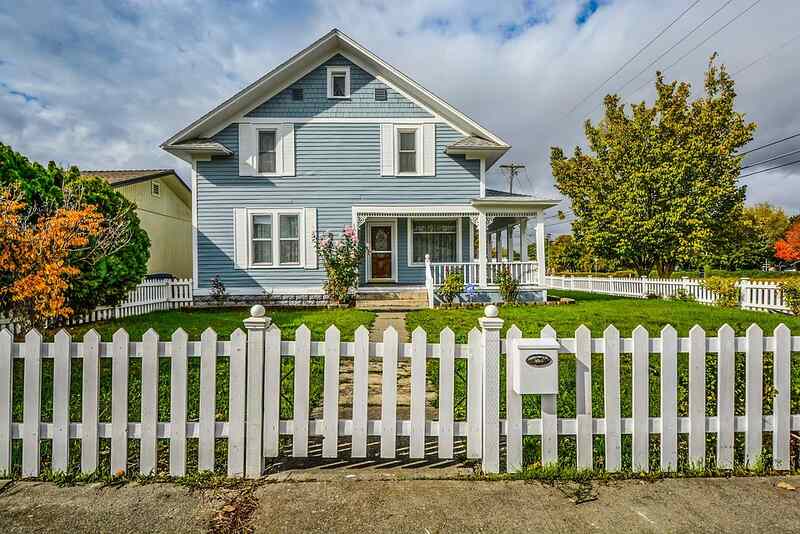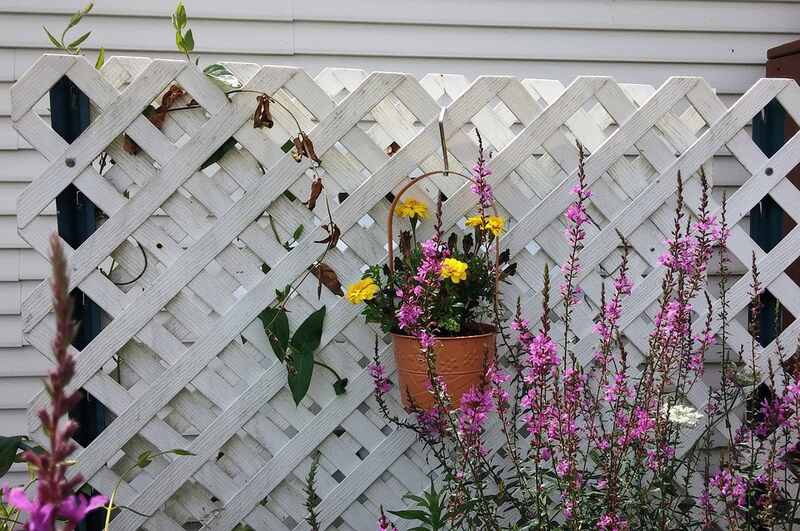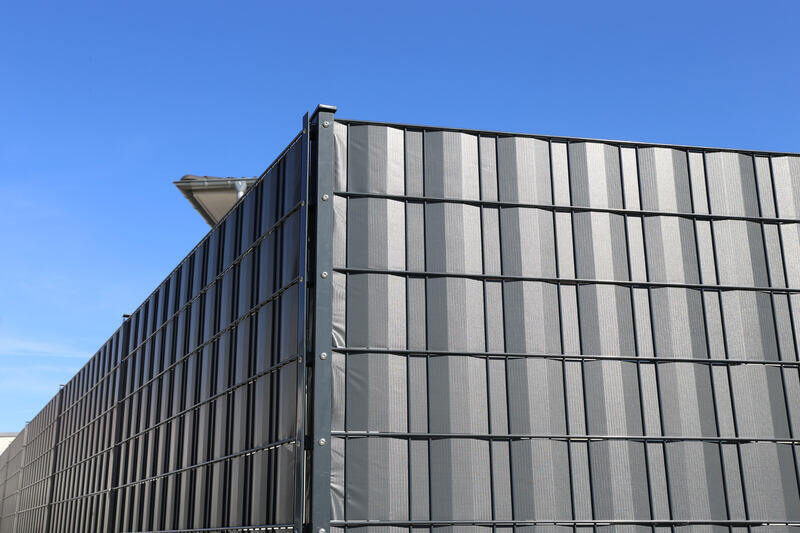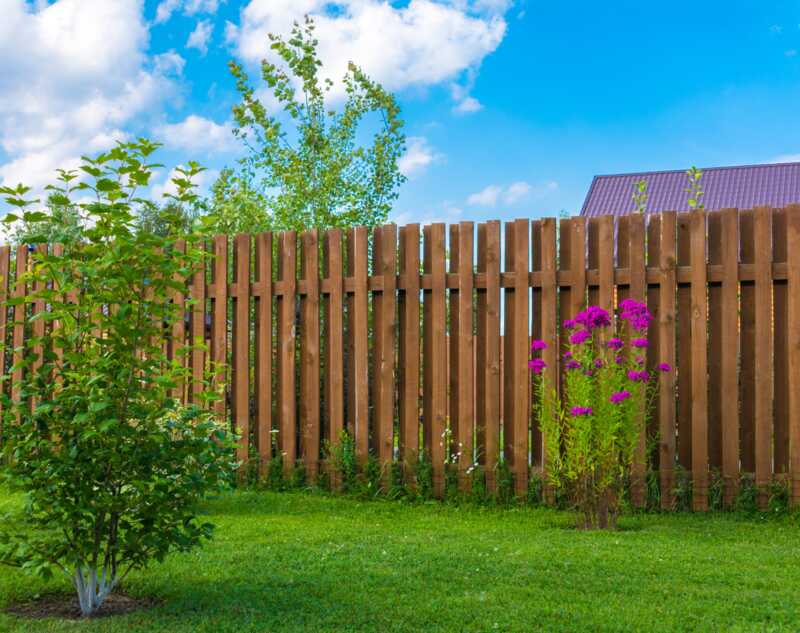
It’s time to install a new fence, but you’re worried it will make your small yard look even smaller. It’s even trickier if you need to contain children, pets, or garden plants. Is it possible to find the perfect fence design that will enhance rather than detract from your yard? Yes — you just need to know the best fence styles for small spaces.
Whether you want visibility, privacy, functionality, or decorative appeal, we’ll review several fence ideas so that you can find the perfect fit for your home.
Best Fence Styles for Small Spaces
With so many design ideas, how are you supposed to choose? We’ll review the advantages and disadvantages of each fence type.
Picket Fences

There’s a reason white picket fences are a favorite. This fencing type is aesthetically appealing with good visibility. Picket fencing looks charming in front yards, though it looks just as lovely in backyards. You can use it as a decorative or protective barrier around gardens and ornamental plants.
Here are some common picket styles:
- Colonial picket fence
- Dog-ear picket fence
- Gothic picket fence
- Angled picket fence
- Scalloped picket fence
- Concave picket fence
- Aluminum picket fence
- Wrought iron fence
However, picket fencing isn’t the best choice for privacy or dog runs. Small dogs could squeeze through the pickets if they aren’t close together, and large dogs could jump over them if they’re not tall enough. You’ll need to carefully maintain the fence because one broken picket could create an easy escape route for your furry friend.
Material options: Wood, vinyl, composite, metal, and bamboo
Cost:
- Wooden pickets: $4-$8.50 per linear foot
- Vinyl pickets: $17-$38 per linear foot
- Composite pickets: $11-$46 per linear foot
- Aluminum pickets: $24-$32 per linear foot
- Wrought iron pickets: $28-$56 per linear foot
- Steel pickets: $23-$45 per linear foot
- Bamboo pickets: $5-$18 per linear foot
Lattice Fences

Lattice is an elegant and versatile design for any small space, coming in various materials and styles. It makes a great property line fence or partition for splitting up a yard. Want a large, open lattice? Go for it. Want a slightly more obscured view? Get lattice fence panels with a tighter weave.
Keep in mind that lattice isn’t entirely private. However, you can get more privacy by growing plants directly on the lattice. You also can hang potted plants from the holes in the lattice. Before doing any of this, make sure your lattice fence is secure and can handle the weight of the plants.
Lattice fences have smaller openings, meaning it’s hard for deer and other wildlife to poke their heads through for a snack. This feature makes it an excellent choice to protect gardens in wildlife-heavy areas. Your dog also won’t be able to sneak through easily without digging, though you’ll still need to maintain the fence to preserve its security.
Material options: Wood, vinyl, composite, metal, and bamboo
Cost: $4-$30 per linear foot
Rail Fences

Rail fences give a rustic and natural appearance to your yard. Need visibility? You’ve got it. Surround your front yard, backyard, or garden. They also look lovely lining pathways or driveways.
Rail fences come in various styles, such as:
- Post and rail fences
- Kentucky board fences
- Round rail fences
- Split rail fences
- Ranch rail fences
- Zig-zag rail fences
- Buck-and-rail fences
Rail fences provide a little security, but not much. You can choose the number of rails to make the gaps bigger or smaller. Want more security? Put wire over the rails to deter animals from coming in or out. However, these fences are not usually very tall, so they’re not the best for animal or dog-proofing.
Material options: Wood, vinyl, composite, metal, and bamboo
Split Rail Fence Cost: $11-$29 per linear foot
Privacy Fences

Whether your view isn’t good or you need privacy from neighbors, sometimes you can’t avoid a tall fence. Wooden and vinyl fences are the most popular for this style.
Choose from several types, including:
- Board-on-board fences
- Horizontal board fences
- Diagonal board fences
- Vertical board fences
- Solid panel fences
- Scalloped fences
- Concave fences
Just go high enough for privacy without making the yard feel cramped. A 6-foot fence is ideal (and the maximum height allowed in many areas); any taller could make you feel trapped. Avoid thick materials like masonry if possible to minimize the space taken up.
Want a taller fence without it looking like a fortress? A lattice fence topper can add a little more height and privacy while still letting light through. Planters also can boost height while adding visual interest to your yard.
Are you worried a privacy fence will make your yard feel too closed off? Combine it with other fencing types to get privacy on the sides where you need it and openness everywhere else.
Privacy fences work best for backyards. Some municipalities don’t allow fencing higher than 4 feet for front yards, and most homeowners prefer to show off the curb appeal of their front yards and homes anyway.
Privacy styles could work for dog and garden fences, but they aren’t ideal if your garden or dog run only takes up a small part of your yard. However, they can effectively block the view of dogs that might get over-excited by neighboring pets or people.
Material options: Wood, vinyl, composite, metal, bamboo, and masonry
Privacy Fence Cost: $14-$36 per linear foot
Semi-Privacy Fences

Semi-privacy fences are perfect for homeowners who need the security of a privacy fence but don’t mind passers-by getting a glimpse inside their yard. They also allow light and air to filter through.
Choose from various styles, including:
- Shadowbox fencing
- Spaced picket fencing
- Alternating picket fencing
- Horizontal spaced picket fencing
- Diagonal spaced picket fencing
- Decorative cut-out fencing
- Scalloped fencing
- Concave fencing
Semi-privacy fencing may be more suitable for the front yard, where you don’t want to block the view of your home completely. It also works well for backyards where complete privacy isn’t necessary, but you want to keep kids and pets in. Like privacy fencing, this style isn’t the best for gardens if they only take up part of your yard. After all, you don’t want to obscure the view of your beautiful produce.
Material options: Wood, vinyl, composite, metal, and bamboo
Cost: $16-$24 per linear foot
Woven Fences
Want your yard to have a cozy or rustic aesthetic? With a woven fence, your space can look like a beautiful nest encircling it. Woven fencing is either made by weaving planks or sticks over and under like a basket. This visually appealing fence style can be a statement piece in your yard without clashing with your decor.
Woven fences can be short, tall, private, or semi-private. They look charming around a garden bed or the border of your yard. They aren’t often used for dog runs, but a tall and sturdy woven fence should be able to contain pets.
Material options: Wood, vinyl, composite, metal, bamboo, and reeds
Cost: $5-$51 per linear foot
Chain-Link Fences

If you’re not too worried about aesthetics, chain-link fences are a practical choice. They’re not too bulky and provide good visibility. Chain-link fencing is inexpensive, easy to install, simple to repair, low-maintenance, and effective at containing children and pets. If you have a digging dog, install your fence with concrete along the bottom.
However, chain-link fences won’t add curb appeal or property value. There are ways to customize chain-link fencing, but you may not find it worthwhile.
Material options: Galvanized, vinyl-coated, aluminum, and stainless steel
Chain-Link Fence Cost: $12-$33 per linear foot
Wire Fences

An affordable alternative to chain-link is wire fencing. Wire fences can have wooden fence posts for aesthetic appeal or metal for longevity. This design has good visibility and looks lovely around gardens. It’s also one of the most affordable fence designs.
Some varieties of wire fencing include:
- Chicken wire
- Welded wire
- Hog wire
- Barbed wire
- Razor wire
While barbed and razor wire fences are more secure, they’re often not allowed in residential areas. They also could be dangerous for anyone inside your yard, especially if your space is small. It wouldn’t be fun to bump accidentally into sharp metal while gardening.
Material options: Metal
Cost: $1-$4 per linear foot
What Makes a Fence Style Good for a Small Space?

How do you know what fence designs will work in your yard?
Several factors make a design harmonize or clash with your outdoor space. You’ll need to consider your must-have features (privacy or protection for children, pets, or gardens) and work from there.
Here are some key design features that could affect your perception of your new fence.
Color
Did you know that fence color can transform how you see your small yard? It may seem like a minor design decision, but a carefully considered color palette could make your yard appear more open or cozy.
- Light colors are reflective, making a space look brighter and more open. These colors also make plants and decorations pop.
- Dark colors absorb light, making a space seem smaller. However, these colors can create a cozy atmosphere.
- Natural colors like green and brown can make fences blend in, especially if they match the surrounding environment. This color scheme could make your yard look more cohesive without harsh border colors. To preserve beautiful natural wood colors, use stains.
- Bright colors make outdoor spaces pop. They’re a space-efficient way to add visual interest to a yard. Choose a color that will complement your house, decor, and garden plants. Want an even more eye-catching fence? Paint a pattern or mural. You also could create the illusion that your yard is larger by painting a landscape onto your fence.
Your fence style also has an impact on how you perceive the color. For example, a white privacy fence will look more striking than a white picket fence.
Thickness
In a small yard, every inch of space counts. A thick fence will take away valuable areas you could work with. That’s why most homeowners opt for thin fencing styles in small spaces.
An open fence design also will give you a little more wiggle room, especially with plants. You can let leaves poke through pickets, but be careful — too much pressure from branches or roots could cause your fence to lean.
Height
If you want a more vast and open space, don’t put yourself in a box. Shorter fences will allow your view to extend beyond your yard’s barriers, making your yard feel less enclosed.
However, sometimes you need privacy — or a tall barrier to stop a high-jumping dog. In that case, you can still provide some openness and light with a semi-privacy fence. Lattice fence toppers also will give extra height without a regular privacy fence’s solid, closed-in design.
You also could use tall fences to divide your yard into “rooms,” such as a play area for the kids and a reading nook for you. Though each area will be small, it could make you feel like there’s more usable space in your yard.
Need a little of everything? Mix tall and short fences depending on your needs. For example, your garden may only need a small barrier to separate it, while your backyard fence can be taller to block prying eyes.
Privacy or Visibility
Height has a significant impact on privacy, but spacing does too.
Here are the fencing styles that provide visibility:
- Picket fences
- Rail fences
- Lattice fences
- Chain-link fences
- Wire fences
If you need privacy, here are a few good styles:
Full Privacy:
- Privacy fences
- Woven fences
Partial Privacy:
- Semi-privacy fences
- Lattice fences
What if you have an existing fence that isn’t private enough? You can add slats to chain-link fences, but you’ll likely need foliage to obscure the view for other fence types.
How To Make Your Yard Look Bigger
Even with the perfect fence, your yard may still feel too small. Here are some tips and tricks to make your tiny outdoor space feel more expansive:
- Don’t overcrowd your yard. Bulky plants, furniture, and decorations can snatch away usable space. Be selective with your plants and furniture so your yard isn’t too cramped.
- Use vertical space if your horizontal space is limited. Try a vertical garden, trellis, pergola, or stepped garden to get the greenery you desire without a garden swallowing up all your outdoor living space.
- Limit your lawn size. While this may seem counterintuitive, it will leave more room for a garden or patio. With more distinct spaces, your yard will feel larger and have more going on.
- Buy two-in-one furniture. There’s no need to buy a storage shelf when your chair opens up. You also can transform existing yard features like stones and tree stumps into furniture or display spaces.
- Install good lighting. Your yard will feel more extensive and welcoming if every corner is bright in the evenings. You also should let natural light in during the day by controlling shady plants and using reflective colors for your decor.
FAQ About the Best Fence Styles for Small Spaces
Yes, but how much varies by design. Open fence designs will minimize this effect, while privacy fences will make it look smaller. You’ll need to weigh the fence’s usefulness against this downside. Don’t feel too bad if you need to install fencing; a beautiful fence with a carefully landscaped yard could distract from its size.
Wire fences are the least-expensive fencing option at $1-$4 per linear foot, including material and professional labor costs. It could be even cheaper as a DIY project.
However, a wire fence may not be secure enough for your needs, especially if you have a dog that likes to dig. In that case, a chain-link fence is your most cost-effective option at $12-$33 per linear foot.
It depends on how the rest of your property looks. Any aesthetically appealing fence will boost your property value, but it will look even more attractive to neighbors or prospective buyers if it matches your home and landscape design. Choose a material, color, and design that match your home’s exterior for the best results.
When to Hire a Fence Contractor
With time and elbow grease, you can build a custom fence to suit your needs. Any style is within your grasp, though some fencing materials are harder to DIY than others.
However, some designs are just too complicated. Metal fences like wrought iron are impossible for the average homeowner to install independently. If you can’t bring your vision to life, maybe a professional could. Contact a local fencing contractor for a quote to help you decide what fence design is right for you.
Main Image Credit: Andrew Balet / Wikimedia Commons / CC BY 3.0